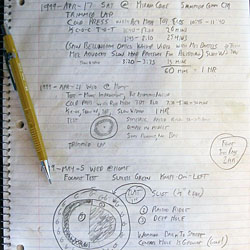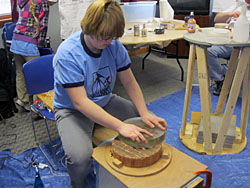Introduction to Figuring
On this page:
- Before Your Start What you need to have already accomplished to start this phase.
- A Change of Pace A word about how this phase is different from what you have done before
- Figuring & Testing The work flow with links to detailed instructions on how to Figure and Test.
- Next Steps A final star test quality check and then aluminizing.
Before You Start
Use this checklist to make sure you are ready to start figuring:
- You have completed Polishing.
- Your Pitch Lap is in good shape. You might want to to review our tips on Lap Maintenance.
- You have Cerium Oxide polishing agent prepared in a Plastic Squeeze Bottle.
- You have access to a Mirror Tester that has a Ronchi Screen for the Ronchi test.
When all the check list items are done or ready, you are ready to start figuring! You may also want to review How to Store Your Lap between figuring sessions.
A Change of Pace
Up to this point, you having been working steadily to get to polished sphere, and the emphasis and pace has been on the physical work. In Testing and Figuring, the emphasis is now on measuring and planning; the actual work on the mirror is just a small fraction of the time spent. We know you are anxious to complete your mirror, but please resist the urge to rush ahead with figuring. Take the time necessary to do good testing, and to plan the work you need to do on the mirror. Spend more time thinking, note taking and pressing than figuring! You will get to your goal sooner that way!
Keeping a Notebook
We strongly urge you to keep a notebook during this phase of work, if you haven't been all along. You should record the results of your testing in the notebook, so you can see how the figure changes with the work you do. Record working temperature (and humidity if you have an easy way to get this info) so you can see how these might impact your progress. Keep track of the time, temperature (hot/warm/cold) and weight used for pressing. And of course, record the work you do on the mirror: what stroke and for how long. You should find this information useful in planning your next work session, as it should help you understand how the many variables involved in figuring have caused your mirror surface to change.
Press Often
It is absolutely essential to keep the lap in good contact with the changing mirror surface shape during figuring. The point of figuring is to change the mirror surface in a predictable, controlled way, and this can't happen if the lap loses contact with the mirror. You need to press often, at the beginning of every figuring session and quiet frequently in between. When parabolizing, you will typically press for 10 to 15 minutes, do about 5 to 15 minutes of work, test, and then repeat the cycle if necessary.
Press On
If you are parabolizing, and getting good, predictable results, keep working if at all possible. Once the lap has good contact with the mirror you don't want to lose this by stopping work for another day, as it may take some time to achieve this state again. Many of us have stayed well beyond the end of mirror class at Stellafane many times to finish a mirror, because we didn't want to lose this magical moment when everything is working well and we are steadily making progress towards an excellent figure.
Don't Give Up Now!
Figuring is the hardest part of mirror making, and the most important. You have to learn testing, which is a whole set of new skills for most people, and it can be challenging. You also have to learn to figure, which takes patience and thoughtfulness: you must think through what you are seeing in the tester, what the surface of your mirror looks like, and why your past actions have gotten you to the current state. Then you must plan how to move from where you are to where you want to go: an excellent parabolic figure. Indeed, figuring and testing is a change of pace, a challenge to learn new skills and apply them thoughtfully. Many people become frustrated, and some give up at this point, because they don't make the change from the physical pace of grinding and polishing to the thoughtful pace of figuring and testing. Take your time, record, think and plan, and your mirror will be a success!
Figuring & Testing
GOAL: Refine the surface of your mirror to be an optically polished good quality section of parabola.
ABRASIVES: Polishing Compund
TOOL: Pitch Lap
STROKES: Various strokes are used depending on the changes in figure to be made. See subsections for appropriate strokes.
TIME: A 6" f/8 or 8" f/6 mirror will typically be figured and tested in 6 to 12 hours or work, depending on mirror size and personal work style. However, times can vary widely, and if you need to return to sphere and try again, these times can multiply by each attempt. Faster (lower f/ number) mirrors take longer, slower mirrors usually take less time.
WORK FLOW
- Test for a Sphere:
It is easiest to begin parabolization if you start from a sphere without any significant problems at the edge. You need to know what shape your mirror surface has before you can figure it, so begin by testing your mirror to see if it is spherical.- If it is spherical with a good edge, jump to Step 3.
- If it is not spherical, or has a bad edge, continue on to Step 2.
- Figure to Sphere:
If your mirror is not spherical, or it has significant edge problems, you need to get it to a good sphere with a good edge before beginning parabolization. Using the familiar center-over-center stroke, we will guide you to correcting problems and get to a good sphere.- Go back to Step1 and Test for a Sphere again.
- Test for A Parabola:
Here we show you how to test for a parabola, and overall quality of your mirror. Most people will do this many times, as they refine their figure from a sphere to a good quality parabola.- If your have a good quality parabola, Congratulations, you are done with figuring!
- If you do not have a good quality parabola, continue on to Step 4.
- Figure to a Parabola:
Here we use a variety of strokes to correct any figuring problems and approach the perfect parabolic figure.- Go back to Step 3 and test the quality of your parabola.
There are many possible states on the way to a good sphere and then parabola, which require many diagrams to describe. The classic book All About Telescopes has all of this information in it. Several years ago it was put into the public domain by its publisher, Edmund Scientific, and it may be downloaded at now charge from several sources on the internet.
Download All About Telescopes from Stellafane.org (29.2 MB PDF)
For Steps 1 and 2 above, refer to Testing & Correcting on pages 94 to 97 in the book.
For Steps 3 and 4 above, refer to Figuring the Paraboloid on pages 98 to 103 in the book.
Their complete section on Mirror Grinding and Testing starts on page 79, and you may find looking though that entire section useful. Note that the page numbers referred to above are the printed page numbers, PDF page numbers are 2 higher.
Next Steps
Now that you have completed figuring and testing, you might want to do a final test of your mirror by testing it in a telescope. Many mirror makers assemble a temporary telescope and star test the un-aluminized mirror to verify the mirror quality.
You will need to have a reflective coating applied to the mirror. See our Mirror Coatings page.
Back to The ATM Main Page



